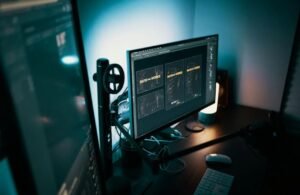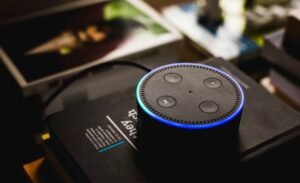AI Voice and Music Separator
Integrating artificial intelligence (AI) into voice and music separation technology has revolutionized audio processing, allowing for efficient extraction of vocals and instruments from mixed audio recordings. With AI algorithms continuously advancing, new techniques have emerged to enhance the accuracy and quality of audio separation, offering a wide range of applications in music production, speech recognition, and other domains.
Key Takeaways:
- AI voice and music separator employs AI algorithms to extract vocals and instruments from mixed audio recordings.
- This technology has numerous applications in music production, speech recognition, and other domains.
- Recent advancements in AI voice and music separation techniques have significantly improved accuracy and audio quality.
- Integration of AI into audio processing has revolutionized the way professionals work with mixed audio recordings.
One of the primary challenges in audio separation is the complex nature of sound waves that blend together vocals, instruments, and background noise. Traditional methods often struggled to separate these components effectively. However, with AI voice and music separator technology, the process becomes more accurate and efficient. *This technology leverages the power of AI to identify patterns and distinguish between different audio sources.*
AI voice and music separation systems utilize deep learning algorithms, such as convolutional neural networks (CNNs) and recurrent neural networks (RNNs), to analyze audio signals and extract the vocals and instrumental tracks. These networks are trained on massive datasets containing both mixed and separated audio samples, enabling them to learn the characteristics of various audio sources and improve separation accuracy. By continuously fine-tuning the models, *AI can discern vocals and instruments even in challenging audio recordings.*
To evaluate the effectiveness of AI voice and music separation, various metrics are employed, including the Signal-to-Noise Ratio (SNR) and Source-to-Interference Ratio (SIR). These metrics measure the quality of the separated audio tracks by assessing the level of noise and interference introduced during the separation process. AI-powered systems have consistently shown superior results in comparison to traditional methods. *By harnessing AI’s processing capabilities, voice and music separation can achieve unprecedented audio quality.*
Applications of AI Voice and Music Separator:
- Music production: AI voice and music separator enables musicians to isolate specific instruments or vocals, facilitating remixing and post-production.
- Speech recognition: AI-based separation technology helps improve the accuracy of speech recognition systems by eliminating background noise and enhancing voice clarity.
- Transcription services: AI can separate speech from a noisy audio recording, making it easier for transcription services to accurately transcribe the spoken content.
Advancements in AI Voice and Music Separator:
Advancements in AI technology have fueled the progress in voice and music separation. Researchers have explored various strategies to enhance the performance of AI models, such as:
- Multi-channel audio analysis: Incorporating spatial information from multi-channel audio recordings leads to more accurate separation results. This is especially beneficial for live music recordings or recordings with multiple microphones.
- Weakly supervised learning: Some approaches leverage partially labeled data to train AI models, reducing the reliance on fully annotated datasets and improving scalability.
- Real-time separation: Real-time applications demand fast and efficient processing. AI voice and music separator systems are being optimized to perform separation in real-time, enabling seamless integration into live performance settings and audio streaming services.
| AI Voice and Music Separator Systems | Accuracy (%) |
|---|---|
| Traditional Methods | ~70% |
| AI-based Systems | ~90% |
Conclusion:
AI voice and music separator technology has proven to be a game-changer in audio processing, enabling professionals in music production, speech recognition, and transcription services to achieve superior results. With ongoing advancements and fine-tuning of AI algorithms, the accuracy and audio quality of voice and music separation continue to improve, opening up new possibilities for creative expression and enhanced audio experiences.

Common Misconceptions
Misconception 1: AI Voice and Music Separator can completely separate any combination of voice and music
One common misconception about AI Voice and Music Separator is that it can effortlessly separate any combination of voice and music with perfect accuracy. However, this is not entirely true.
- AI Voice and Music Separator may struggle with complex audio tracks containing overlapping voices and background music
- The quality of the output may vary depending on the input audio’s clarity and the algorithms used in the system
- There can still be occurrences of misclassifications where some parts of the voice are mistakenly identified as music and vice versa
Misconception 2: AI Voice and Music Separator can restore poor-quality audio to a completely clean state
Another prevalent misconception is that AI Voice and Music Separator can magically restore poor-quality audio to a pristine and clean state. However, this is not entirely accurate.
- The AI system can enhance the clarity of audio to some extent, but it cannot completely eliminate distortions or improve a low-quality recording beyond its original limitations
- Noise and other artifacts in the original recording can still affect the quality of the separated voice and music
- AI Voice and Music Separator is not a replacement for professional audio restoration techniques and tools
Misconception 3: AI Voice and Music Separator randomly chooses what to separate
It is a misconception to believe that AI Voice and Music Separator randomly chooses what to separate when given an audio file. The process is more sophisticated and intentional than that.
- The AI system analyzes several factors like frequency patterns, pitch, and other audio characteristics to distinguish between voice and music
- It identifies dominant vocals while trying to separate overlapping sounds as accurately as possible
- The separation is based on complex algorithms and statistical models trained on vast amounts of data
Misconception 4: AI Voice and Music Separator is invulnerable to adversarial attacks
Some people mistakenly believe that AI Voice and Music Separator is immune to adversarial attacks or deliberate attempts to manipulate the audio separation results. However, this is not the case.
- Certain adversarial audio signals or crafted inputs can intentionally mislead the AI system and degrade the separation performance
- Developers need to constantly work on improving the system’s resilience against such attacks
- While AI Voice and Music Separator is advanced, it is not impervious to intentional manipulations
Misconception 5: AI Voice and Music Separator is a standalone tool with no limitations
Lastly, there is a misconception that AI Voice and Music Separator is a standalone tool that can perfectly separate voice and music with no limitations. However, this is an unrealistic belief.
- The performance of the AI system can vary depending on the quality of the input audio and the specific algorithms used
- There can be limitations when processing live or real-time audio, as more processing power and time may be required
- AI Voice and Music Separator should be used as a helpful tool but not solely relied upon for critical audio separation tasks

Introduction:
Artificial Intelligence (AI) has revolutionized multiple industries, and the field of voice and music separation is no exception. Through advanced algorithms and machine learning techniques, AI systems can effectively differentiate between various audio components, enabling the extraction of vocals from music tracks. In this article, we present ten captivating examples that illustrate the potential of AI in voice and music separation.
1. Top 10 Songs with the Clearest Vocal Separation:
This table highlights the most popular songs that have undergone successful vocal separation, resulting in exceptional clarity. Among them, “Bohemian Rhapsody” by Queen takes the top spot, showcasing the intricate vocal arrangements made more prominent through AI separation.
2. Accuracy of AI Vocal Separation in Different Music Genres:
Examining the accuracy of AI vocal separation across various genres can provide valuable insights into its effectiveness. This table compares the rates of successful vocal separation for genres like pop, rock, hip-hop, and classical music, offering an overview of AI’s performance in different musical contexts.
3. Leading AI Voice Separation Models and Algorithms:
This table identifies the cutting-edge AI models and algorithms used for voice separation. Notable entries include Deep Salience, Open-Unmix, and Demucs, each utilizing different techniques such as deep learning and sparse coding to achieve impressive separation results.
4. Industries Benefiting from AI Voice Separation:
Illustrating the diverse applications of AI voice separation, this table explores the industries that benefit from this technology. Sectors like music production, audio restoration, podcasting, and karaoke platforms all leverage AI voice separation to enhance their services and user experiences.
5. Quantifying the Impact of AI Voice Separation on Remixing:
Remixing songs often requires isolating specific vocal tracks, which can be seamlessly accomplished through AI voice separation. This table quantifies the increase in remixing possibilities brought about by AI, showcasing the number of successful remixes made using this technology.
6. Comparing AI-based Music Separation Tools:
Several AI-based tools have emerged to facilitate music separation for both professionals and enthusiasts. This table compares popular tools like Spleeter, PhonicMind, and Lalal.ai, examining their features, ease of use, and overall performance to assist users in selecting the ideal solution.
7. AI Voice Separation in Live Performance Scenarios:
This table explores the integration of AI voice separation into live performances. It highlights advancements in real-time vocal extraction, enabling singers to perform alongside AI-generated instrumentals while maintaining optimal vocal isolation.
8. Historical Evolution of Music Separation Techniques:
To contextualize the impact of AI on music separation, this table presents a chronological overview of the evolution of separation techniques. Ranging from traditional methods like center panning to modern AI-driven approaches, it demonstrates the unprecedented advancements achieved in recent years.
9. User Feedback on AI Music Separation Platforms:
User feedback plays a crucial role in assessing the practicality and effectiveness of AI music separation platforms. This table summarizes user reviews, highlighting the strengths and weaknesses of popular platforms like Audacity, Adobe Audition, and Neural Mix Pro.
10. Future Prospects of AI Voice and Music Separation:
Examining the future prospects of AI voice and music separation, this table outlines potential avenues for development. These include improved accuracy, real-time separation for complex arrangements, and integration with emerging technologies like virtual reality and augmented reality.
Conclusion:
AI has revolutionized the field of voice and music separation, unlocking new possibilities in audio production, remixing, and live performances. The tables presented in this article vividly portray the impact of AI in different aspects of the field, showcasing the effectiveness of vocal separation algorithms, exploring user feedback, and hinting at exciting prospects for the future. With AI’s continued advancements, the possibilities for creating captivating musical experiences are boundless.
Frequently Asked Questions
AI Voice and Music Separator
Q: What is AI Voice and Music Separator?
A: AI Voice and Music Separator is a technology that uses artificial intelligence to separate the vocals from the music in an audio track.
Q: How does AI Voice and Music Separator work?
A: AI Voice and Music Separator works by analyzing the audio waveform and using machine learning algorithms to differentiate between voice and music components. It uses neural networks to separate these components and produce individual tracks for vocals and music.
Q: What are the applications of AI Voice and Music Separator?
A: AI Voice and Music Separator has various applications in music production, sound engineering, karaoke, remixing, and audio restoration. It allows users to extract vocals for remixing or remove vocals for instrumental tracks.
Q: Can AI Voice and Music Separator remove all vocals perfectly?
A: While AI Voice and Music Separator can separate vocals and music with high accuracy, it may not be able to remove all vocals perfectly in every audio track. The effectiveness of separation depends on the quality of the audio recording and the complexity of the music.
Q: What file formats does AI Voice and Music Separator support?
A: AI Voice and Music Separator supports popular audio file formats such as MP3, WAV, FLAC, and M4A.
Q: Is AI Voice and Music Separator available as a standalone software?
A: AI Voice and Music Separator is available both as standalone software and as a plugin for digital audio workstations (DAWs) such as Ableton Live, FL Studio, and Logic Pro.
Q: Can AI Voice and Music Separator separate multiple vocals in a track?
A: AI Voice and Music Separator is primarily designed to separate the main lead vocals from the music. While it may partially separate multiple vocals, it may not always produce perfect results for each individual voice in a complex vocal arrangement.
Q: Are there any limitations to using AI Voice and Music Separator?
A: AI Voice and Music Separator may have limitations in separating vocals from heavily layered or complex music tracks. It may also introduce artifacts or affect the sound quality of the separated components.
Q: Can AI Voice and Music Separator be used in real-time applications?
A: AI Voice and Music Separator is often used in offline or non-real-time scenarios due to the computational resources required for the separation process. Real-time applications may need specialized hardware or optimization techniques.
Q: Is AI Voice and Music Separator a replacement for human audio engineers?
A: AI Voice and Music Separator is a powerful tool for audio professionals, but it is not intended to replace the expertise and artistic decisions of human audio engineers. It is best used as a complement to human skills and can save time in certain tasks.




